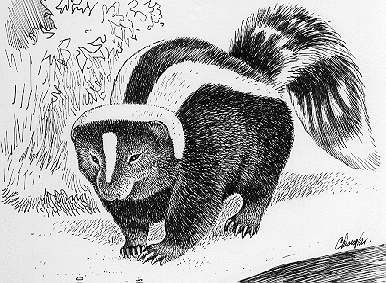Stripped Skunk - (Mephitis mephitis)
I am glad and excited to report that a stripped skunk seems to have moved onto my property. It has been spotted three times this summer of 1998. It seems to be young. We are hoping it stays.

![]()

Striped Skunks (babies)
![]()
Fiction: All skunks are born rabies carriers.
Fact: Skunks, like any other mammal, only get rabies when infected by another rabid animal. Typically, skunks get rabies by either getting bitten by or eating the carrion of a rabid animal.
Fiction: A skunk's defensive spray is its urine.
Fact: A skunk's spray is not urine. It is a musk produced by a pair of 'musk glands' about 3/4" in diameter and located on both sides of the rectum. Although similar glands appear in many other mammalian species, the skunk's must glands are highly developed.
Fiction: Skunks attack with their musk.
Fact: Skunks only use their musk for defense, not for attacking. I remember reading that the only time a skunk sprays another skunk is when two males fight over a female, however other sources say no. (A friend of mine witnessed a pair of skunks fighting in his backyard and said the area smell strongly of musk so I suspect the answer is 'sometimes')
Fiction: When a skunk uses its musk for defense, it sprays a little on its tail and then 'flings' it at an enemy with a quick tail-flick.
Fact: I'm not sure
where this myth came from, but it could be a misinterpretation of
a striped skunks's warning display. [ skunks instinctively raise
their tail like a warning flag when startled... other warnings
include hissing, back-arching, foot-stamping, and hand-stands
(most often for
spotted skunks). ]
Skunks don't need to 'fling' the musk at all... Powerful muscles surround the skunk's musk glands which can squeeze the musk out of a pair of 'retractable nipples' located on each side of the anus. This spray can reach an enemy 10 to 15 feet away. Often little or no musk gets on the skunk's fur. Skunks apparently try to avoid getting ANY musk on their fur.
The PBS documentary series "Wild America" showed this on their episode titled "Those Smelly Skunks". Click on this link to see the musk spraying segment [828k]. This shows the 'retractable nipples' in action. WARNING: EXTREME GROSS-OUT ALERT
Fiction: A skunk cannot spray when held up by its tail.
Fact: Apparently this is still up in the air (no pun intended). Sometimes a skunk will spray when held up by its tail... sometimes it won't. It appears to depend on the individual. The big question is: What provokes some skunks to spray when held by their tails and others not to? An article by Richard van Gelder [Natural History, Aug. 1990, pp6+] suggests that if a skunk is lifted by its tail BEFORE it gets agitated enough to protrude its 'retractable nipples' then it cannot spray. If lifted after the nipples protrude, then a skunk can successfully spray. Jerry Dragoo (as seen on the 'skunk experts' list on these pages) disagrees with van Gelder and belives it depends on the skunk's personality and perception of danger... 'does it feel threatened enough to use its musk?' [his reply to van Gelder is in Natural History, Oct, 1990, p4 (letters section)].
P.S. It might look
cruel, but skunk's tails are strong and picking up a skunk this
way shoudn't hurt it as long as you pick it up by the BASE OF THE
TAIL
(never the end) and as long as the skunk is not greatly
overweight.
Fiction: Skunk spray can cause permanent blindness.
Fact: The spray, if gotten into the eyes, often causes temporary blindness (and also burns like heck), but apparently there aren't any cases documented where it has caused permanent blindness.
Fiction: A skunk's musk consists of 1-Butanethiol.
Fact: This is from a century-old chemical analysis. T.B. Aldritch [J. of Experimental Medicine, v. 1 p323-340, 1896] examined skunk musk and claimed it was primarily 1-Butanethiol (a/k/a n-Butyl Mercaptan). Many books which talk about skunks continue to use Aldritch's results.
A much more recent analysis of the 'volatile' components of the musk shows 7 chemicals (for striped skunks), one component had never before been seen in nature and another had never been reported anywhere (natural or man-made) yet none of them were 1-Butanethiol. Two were minor variants. The following page describes this analysis of skunk spray.
![]()
![]()
 Wildflower
Seed For Sale
Wildflower
Seed For Sale